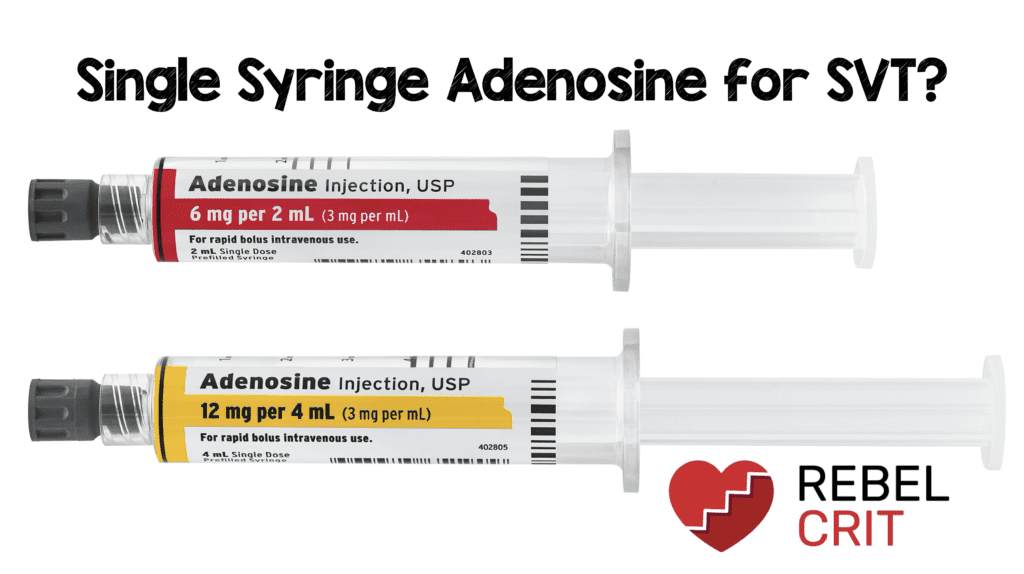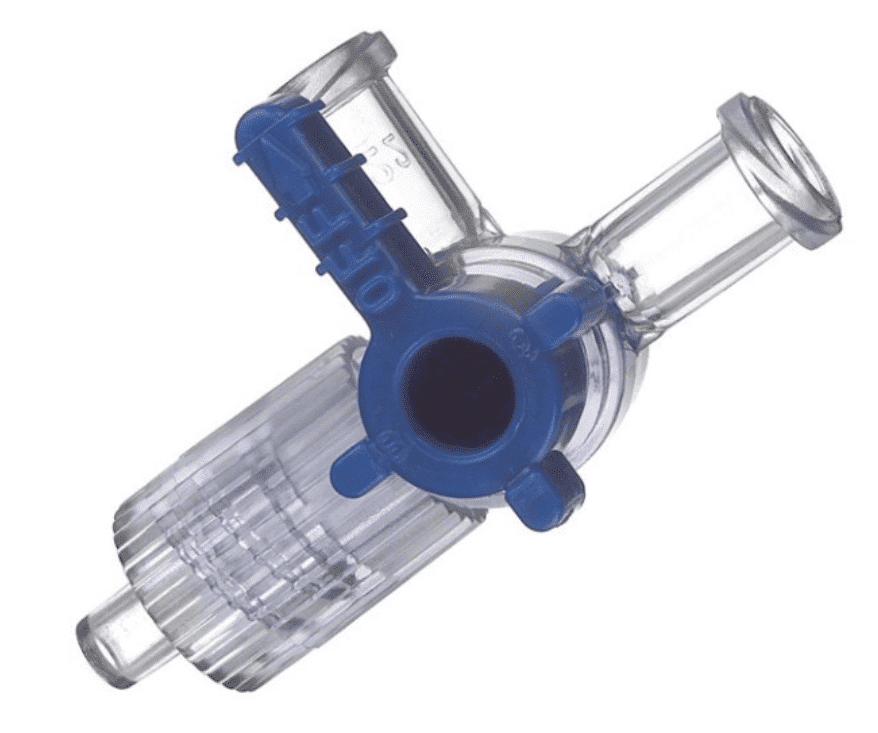
 Background: The 2015 American Heart Association guidelines for Adult Advanced Cardiac Life Support recommend adenosine in non-hypotensive patients in regular narrow-complex supraventricular tachycardia (SVT). Adenosine has a rapid onset and a half-life that is <10 seconds, which makes it an ideal agent for hemodynamically stable SVT. Typically, adenosine is administered as an initial 6mg rapid IV bolus over 1 – 2 seconds followed by a rapid 10 – 20mL saline flush. If SVT is not terminated and normal sinus rhythm maintained within 1 – 2 minutes, a repeat dose of 12mg is given followed by a 10 – 20mL saline flush, and this can be repeated for a total of 3 doses. Because of the short half-life of adenosine, several advocate for a two-way stopcock, where adenosine and a 10 – 20mL saline flush are given in tandem. The logistics and timing with using a two way stopcock can be challenging and can result in less rapid flush than intended.
Background: The 2015 American Heart Association guidelines for Adult Advanced Cardiac Life Support recommend adenosine in non-hypotensive patients in regular narrow-complex supraventricular tachycardia (SVT). Adenosine has a rapid onset and a half-life that is <10 seconds, which makes it an ideal agent for hemodynamically stable SVT. Typically, adenosine is administered as an initial 6mg rapid IV bolus over 1 – 2 seconds followed by a rapid 10 – 20mL saline flush. If SVT is not terminated and normal sinus rhythm maintained within 1 – 2 minutes, a repeat dose of 12mg is given followed by a 10 – 20mL saline flush, and this can be repeated for a total of 3 doses. Because of the short half-life of adenosine, several advocate for a two-way stopcock, where adenosine and a 10 – 20mL saline flush are given in tandem. The logistics and timing with using a two way stopcock can be challenging and can result in less rapid flush than intended.
From Research to Practice Episode 5.0 – Single Syringe Adenosine for Hemodynamically Stable SVT
[embedyt] https://www.youtube.com/watch?v=b6GZSENy3jE[/embedyt]
Also Be Sure to Checkout our YouTube Channel

What They Did:
- Single-center, prospective, observational non-inferiority study
- Evaluate the administration technique of adenosine delivered as a single-syringe (SS) diluted with saline compared to the two-syringe method for conversion of SVT to normal sinus rhythm (NSR)
- Adenosine preparation:

- SS = 6mg adenosine + 18mL of 0.9% sodium chloride
- TS = Two separate syringes of adenosine and 20mL 0.9% sodium chloride
- If conversion to NSR was not achieved, the dose of adenosine was increased to 12mg in both groups and given via the same administration method previously used
Outcomes:
- Primary: Percentage of patients with successful conversion of SVT to NSR after the first does
- Secondary:
- Achievement of NSR up to 3 doses
- Adverse effects secondary to administration technique
Inclusion:
- Age ≥18 years of age
- Presenting to the ED
- Stable narrow-complex regular rhythm tachycardia
Exclusion:
- SBP <90mHg
- Evidence of poor perfusion
- History of bronchospasm
Results:
- 53 patients enrolled
-
Successful Conversion to NSR With 1st Dose:
- SS: 73.1% (95% CI = 0.55 – 0.91)
- TS: 40.7% (95% CI = 0.21 – 0.61)
- Noninferiority p = 0.0176
-
Successful Conversion to NSR With Up to 3 Doses:
- SS: 100% (95% CI 1.0 – 1.0)
- TS: 70.4% (95% CI 0.52 – 0.89)
- Noninferiority p = 0.0043
- 1 patient in the TS arm developed extravasation and phlebitis compared to none in the SS arm
Strengths:
- Asks an important question about the logistics and ease of administration of adenosine
- Baseline characteristics were similar between groups
Limitations:
- Study was underpowered and required 75 patients per arm, but only 53 patients were enrolled in the study total
- Non-randomized trial allowing clinicians to decide which approach to use which adds bias to the study
- Event numbers were too small to assess adverse effects
- Location of IV access was not recorded, as distal lines could potentially confound the rates of NSR conversion
- The administration technique for the TS method was not recorded and not standardized (i.e. stopcock, single-port IV, two-port IV, etc)
- Did not exclude patients who may have received additional rate controlling medications prior to adenosine administration, which could also confound results
Discussion:
- As with anything in medicine, it is important to have respect for the scientific method and although the authors should be applauded for this study, their numbers are too small, and this paper should be looked at as initial data that requires further research. The authors even state, “Most importantly, observational studies can provide erroneous conclusions.”
- There was another study by Choi et al [2] that looked at SS administration using only 15mL of saline to dilute adenosine vs TS method in 65 patients with paroxysmal SVT. They did not report 1st dose success rates but showed a successful termination of SVT with 80 and 85.7% success rates using the SS and TS method respectively, that was not statistically different.
- The success rate of the TS method is low in this study. As shown in the Choi et al [2] study, most people will typically hit mid to high 80s. What isn’t clear is if this is a reflection of bias in the study since clinicians knew what they were giving (biased to the SS method) or is this simply a case of there would be a regression to the mean with additional patients?
- My practice is that in patients with stable SVT, my go to move would be modified Valsalva maneuver, which has been shown to have a conversion rate of nearly 40% in 3 studies now. If this is not successful, my next agent would be a calcium channel blocker, as adenosine gives patients a sense of impending doom. For more on this check out Justin Morgenstern’s great post at First10EM.
Author Conclusion: “In conclusion, the SS administration method is simple and no less effective than the TS method. Physicians should consider using the SS method particularly if no stopcock is available or if only a single-port-IV can be used for drug administration. Further randomized control studies should be completed to validate these results.”
Clinical Take Home Point: From a pragmatic standpoint, single syringe adenosine makes sense, and although we now have two small studies that show single syringe adenosine to be non-inferior to two syringe adenosine, we have to be cautious about making robust conclusions based on this level of evidence. In this study we don’t know the location of IVs, the two syringe technique used, what other medications were given, and the numbers are simply too small to make any comments on adverse events.
References:
- McDowell M et al. Single-Syringe Administration of Diluted Adenosine. Acad Emerg Med 2019. PMID: 31665806
- Choi SC et al. A Convenient Method of Adenosine Administration for Paroxysmal Supraventricular Tachycardia. J Korean Soc Emerg Med 2003. [Link is HERE]
For More Thoughts on This Topic Checkout:
- First10EM: Would You Choose Adenosine?
Post Peer Reviewed By: Anand Swaminathan, MD (Twitter: @EMSwami)
The post Single Syringe Adenosine for SVT? appeared first on REBEL EM - Emergency Medicine Blog.

